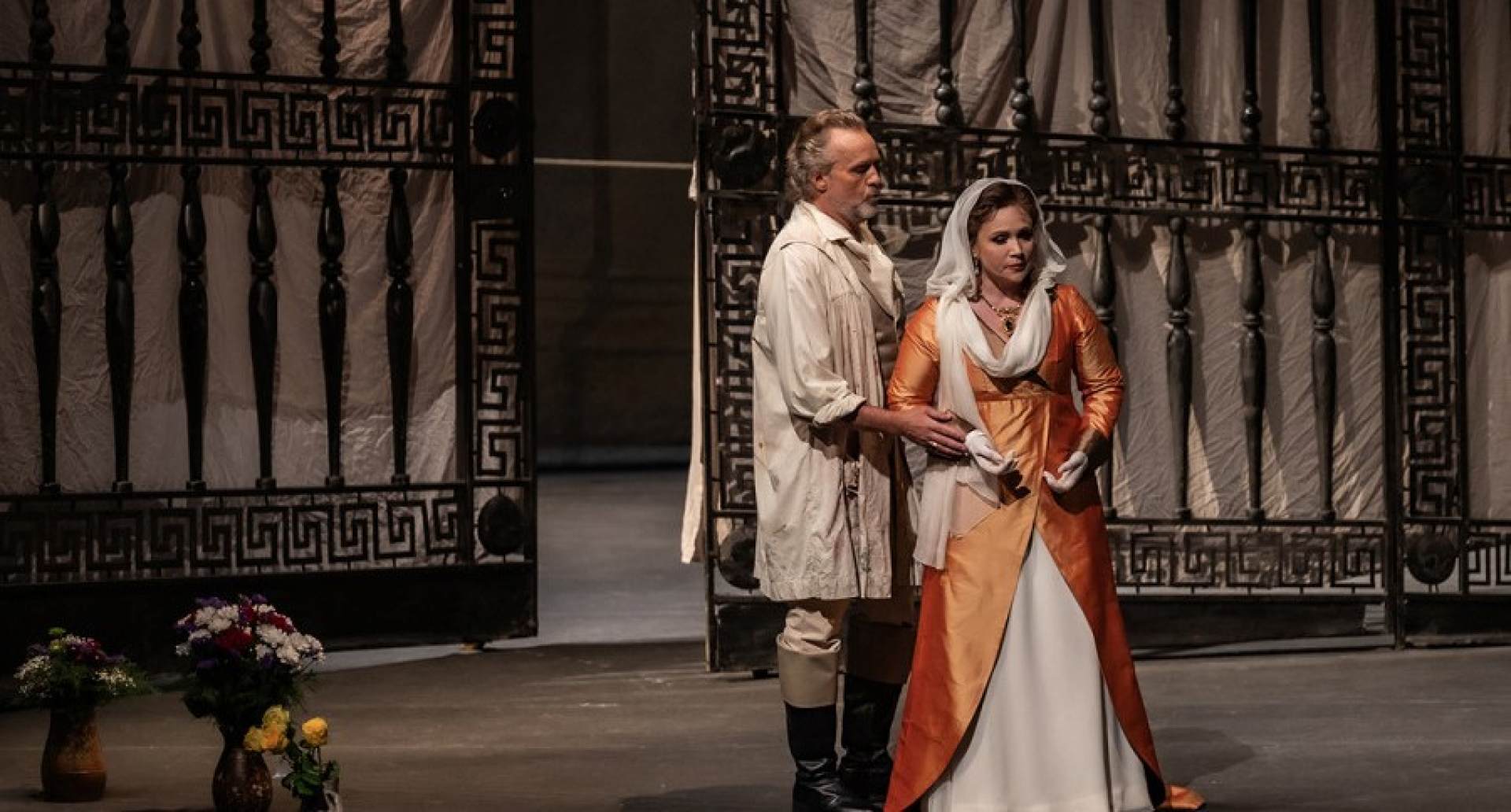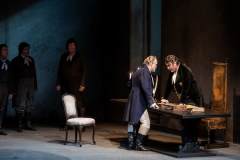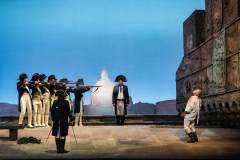Tosca
Mo | Tu | We | Th | Fr | Sa | Su |
Tosca - Giacomo Puccini (1858 – 1924)
Melodramma in 3 acts
Libretto by Giuseppe Giacosa and Luigi Illica
based on the drama LA TOSCA by Victorien Sardou
First performed on 14th January 1900 in Rome
Premiered at the Deutsche Oper Berlin on 13th April 1969
Recommended for ages 13 and up.
About the performance
About the work
As in all operas by Puccini, TOSCA is an illustration of how human attentiveness and pleasures of the palate can be mutually dependent if the composer’s artistic intentions become a benchmark for directorial interpretation. Puccini’s humane attentiveness is essentially dependent on an outcry and/or a sense of resignation. The pity inherent in his music does not content itself with abstract gestures; it wants to unsettle, to bring about change. Out of the “small things” named by Puccini as the source of his inspiration and the focus of his music “big things” grow – as long as we want them. Puccini’s choice of material owes something, directly or indirectly, to the spirit of Zola, Gorki and Hauptmann, and the link between that material and his compositional style places him likewise as a direct descendant of Verdi and an exponent of verismo. He was also known as an admirer of Wagner, although a Wagner imitator he assuredly was not.
It was more a case of a personal connection based on selected achievements of both composers. Grappling with the bundled subtleties of harmony and nuances of instrumentation, he still uncovered a voice from the orchestral cross-hatching and gave it an accompagnato that was considerably more fractured and refined than the radical and laconic Verdi was wonted to do. This is also a reflection of the aesthetic themes of TOSCA. The music exudes brutality, intelligence and exactitude but also tenderness, sentimentality and a dream-like quality. Puccini set great store on musical precision, social awareness, a tactical heroism, the poetics of the seemingly hum-drum, the contrast between aloofness and passionate involvement, and following his true north.
Scarpia, the police chief, Floria Tosca, a singer, and Cavaradossi, a painter, are all bent on achieving their own personal forms of liberty. Scarpia’s is all about asserting his idea of power; Cavaradossi’s is that of the freedom fighter seeking systemic change; Tosca’s is the release that comes with private, straightforward, unbounded love. At a pivotal time of major upheaval these urges assume a heightened significance. Depending on the stance that we see ourselves and Puccini in at that moment in time, TOSCA either remains a grisly love story or ends up as a portent of “freedom”. In any event, each of the three very different protagonists pay for their part in this triangular clinch with their lives. There is nothing redemptive about their deaths, which are grim, violent and definitive.
Synopsis
Act 1
Inside the church of Sant'Andrea della Valle
Cesare Angelotti, former consul of the Roman Republic and now an escaped political prisoner, runs into the church and hides in the Attavanti private chapel – his sister, the Marchesa Attavanti, has left a key to the chapel hidden at the feet of the statue of the Madonna. The elderly Sacristan enters and begins cleaning. The Sacristan kneels in prayer as the Angelus sounds.
The painter Mario Cavaradossi arrives to continue work on his picture of Mary Magdalene. The Sacristan identifies a likeness between the portrait and a blonde-haired woman who has been visiting the church recently (unknown to him, it is Angelotti's sister the Marchesa). Cavaradossi describes the "hidden harmony" ("Recondita armonia") in the contrast between the blonde beauty of his painting and his dark-haired lover, the singer Floria Tosca. The Sacristan mumbles his disapproval before leaving.
Angelotti emerges and tells Cavaradossi, an old friend who has republican sympathies, that he is being pursued by the Chief of Police, Baron Scarpia. Cavaradossi promises to assist him after nightfall. Tosca's voice is heard, calling to Cavaradossi. Cavaradossi gives Angelotti his basket of food and Angelotti hurriedly returns to his hiding place.
Tosca enters and suspiciously asks Cavaradossi what he has been doing – she thinks that he has been talking to another woman. After Cavaradossi reassures her, Tosca tries to persuade him to take her to his villa that evening: "Non la sospiri, la nostra casetta" ("Do you not long for our little cottage"). She then expresses jealousy over the woman in the painting, whom she recognises as the Marchesa Attavanti. Cavaradossi explains the likeness; he has merely observed the Marchesa at prayer in the church. He reassures Tosca of his fidelity and asks her what eyes could be more beautiful than her own: "Qual'occhio al mondo" ("What eyes in the world").
After Tosca has left, Angelotti reappears and discusses with the painter his plan to flee disguised as a woman, using clothes left in the chapel by his sister. Cavaradossi gives Angelotti a key to his villa, suggesting that he hide in a disused well in the garden. The sound of a cannon signals that Angelotti's escape has been discovered. He and Cavaradossi hasten out of the church.
The Sacristan re-enters with choristers, celebrating the news that Napoleon has apparently been defeated at Marengo. The celebrations cease abruptly with the entry of Scarpia, his henchman Spoletta and several police agents. They have heard that Angelotti has sought refuge in the church. Scarpia orders a search, and the empty food basket and a fan bearing the Attavanti coat of arms are found in the chapel. Scarpia questions the Sacristan, and his suspicions are aroused further when he learns that Cavaradossi has been in the church; Scarpia mistrusts the painter, and believes him complicit in Angelotti's escape.
When Tosca arrives looking for her lover, Scarpia artfully arouses her jealous instincts by implying a relationship between the painter and the Marchesa Attavanti. He draws Tosca's attention to the fan and suggests that someone must have surprised the lovers in the chapel. Tosca falls for his deceit; enraged, she rushes off to confront Cavaradossi. Scarpia orders Spoletta and his agents to follow her, assuming she will lead them to Cavaradossi and Angelotti. He privately gloats as he reveals his intentions to possess Tosca and execute Cavaradossi. A procession enters the church singing the Te Deum; exclaiming 'Tosca, you make me forget even God!', Scarpia joins the chorus in the prayer.
Act 2
Scarpia's apartment in the Palazzo Farnese, that evening
Scarpia, at supper, sends a note to Tosca asking her to come to his apartment, anticipating that two of his goals will soon be fulfilled at once. His agent, Spoletta, arrives to report that Angelotti remains at large, but Cavaradossi has been arrested for questioning. He is brought in, and an interrogation ensues. As the painter steadfastly denies knowing anything about Angelotti's escape, Tosca's voice is heard singing a celebratory cantata elsewhere in the Palace.
She enters the apartment in time to see Cavaradossi being escorted to an antechamber. All he has time to say is that she mustn't tell them anything. Scarpia then claims she can save her lover from indescribable pain if she reveals Angelotti's hiding place. She resists, but the sound of screams coming through the door eventually breaks her down, and she tells Scarpia to search the well in the garden of Cavaradossi's villa.
Scarpia orders his torturers to cease, and the bloodied painter is dragged back in. He is devastated to discover that Tosca has betrayed his friend. Sciarrone, another agent, then enters with news: there was an upset on the battlefield at Marengo, and the French are marching on Rome. Cavaradossi, unable to contain himself, gloats to Scarpia that his rule of terror will soon be at an end. This is enough for the police to consider him guilty, and they haul him away to be executed.
Scarpia, now alone with Tosca, proposes a bargain: if she gives herself to him, Cavaradossi will be freed. She is revolted, and repeatedly rejects his advances, but she hears the drums outside announcing an execution. As Scarpia awaits her decision, she prays, asking why God has abandoned her in her hour of need: "Vissi d'arte" ("I lived for art"). She tries to offer money, but Scarpia is not interested in that kind of bribe: he wants Tosca herself.
Spoletta returns with the news that Angelotti has killed himself upon discovery, and that everything is in place for Cavaradossi's execution. Scarpia hesitates to give the order, looking to Tosca, and despairingly she agrees to submit to him. He tells Spoletta to arrange a mock execution, both men repeating that it will be "as we did with Count Palmieri", and Spoletta exits.
Tosca insists that Scarpia must provide safe-conduct out of Rome for herself and Cavaradossi. He easily agrees to this and heads to his desk. While he's drafting the document, she quietly takes a knife from the supper table. Scarpia triumphantly strides toward Tosca. When he begins to embrace her, she stabs him, crying "this is Tosca's kiss!" Once she's certain he's dead, she ruefully says "now I forgive him." She removes the safe-conduct from his pocket, lights candles in a gesture of piety, and places a crucifix on the body before leaving.
Act 3
The upper parts of the Castel Sant'Angelo, early the following morning
A shepherd boy is heard offstage singing (in Romanesco dialect) "Io de' sospiri" ("I give you sighs") as church bells sound for matins. The guards lead Cavaradossi in and a jailer informs him that he has one hour to live. He declines to see a priest, but asks permission to write a letter to Tosca. He begins to write, but is soon overwhelmed by memories: "E lucevan le stelle" ("And the stars shone").
Tosca enters and shows him the safe-conduct pass she has obtained, adding that she has killed Scarpia and that the imminent execution is a sham. Cavaradossi must feign death, after which they can flee together before Scarpia's body is discovered. Cavaradossi is awestruck by his gentle lover's courage: "O dolci mani" ("Oh sweet hands"). The pair ecstatically imagine the life they will share, far from Rome. Tosca then anxiously coaches Cavaradossi on how to play dead when the firing squad shoots at him with blanks. He promises he will fall "like Tosca in the theatre".
Cavaradossi is led away, and Tosca watches with increasing impatience as the firing squad prepares. The men fire, and Tosca praises the realism of his fall, "Ecco un artista!" ("What an actor!"). Once the soldiers have left, she hurries towards Cavaradossi, urging him, "Mario, su presto!" ("Mario, up quickly!"), only to find that Scarpia betrayed her: the bullets were real. Heartbroken, she clasps her lover's lifeless body and weeps.
The voices of Spoletta, Sciarrone, and the soldiers are heard, shouting that Scarpia is dead and Tosca has killed him. As the men rush in, Tosca rises, evades their clutches, and runs to the parapet. Crying "O Scarpia, avanti a Dio!" ("O Scarpia, we meet before God!"), she flings herself over the edge to her death.
Program and cast
Duration: 3 hrs 15 mins / 2 intervals
In Italian with German and English surtitles
Pre-performance lecture (in German): 45 minutes prior to each performance
Cast
Conductor: Sir Donald Runnicles, Ivan Repušić (13.11.2025), Giampaolo Bisanti (19.04.2026 | 23.04.2026)
Director: Boleslaw Barlog
Stage-design, Costume-design: Filippo Sanjust
Chorus Director: Thomas Richter
Children's Chorus: Christian Lindhorst
Tosca: Carmen Giannattasio, Anastasia Bartoli (19.04.2026 | 23.04.2026)
Mario Cavaradossi: Brian Jagde, Freddie De Tommaso (19.04.2026 | 23.04.2026)
Scarpia: Ivan Inverardi, Amartuvshin Enkhbat (19.04.2026 | 23.04.2026)
Angelotti: Joel Allison, Byung Gil Kim (19.04.2026 | 23.04.2026)
Sacristan: Padraic Rowan
Spoletta: Matthew Peña, Jörg Schörner (19.04.2026 | 23.04.2026)
Sciarrone: Jared Werlein, Volodymyr Morozov (19.04.2026 | 23.04.2026)
Turnkey: Benjamin Dickerson
Chorus: Kinderchor der Deutschen Oper Berlin
Chorus: Chor der Deutschen Oper Berlin
Orchestra: Orchester der Deutschen Oper Berlin
Deutsche Oper Berlin
The Deutsche Oper Berlin is an opera company located in the Charlottenburg district of Berlin, Germany. The resident building is the country's second largest opera house and also home to the Berlin State Ballet.
The company's history goes back to the Deutsches Opernhaus built by the then independent city of Charlottenburg—the "richest town of Prussia"—according to plans designed by Heinrich Seeling from 1911. It opened on November 7, 1912 with a performance of Beethoven's Fidelio, conducted by Ignatz Waghalter. After the incorporation of Charlottenburg by the 1920 Greater Berlin Act, the name of the resident building was changed to Städtische Oper (Municipal Opera) in 1925.
Deutsches Opernhaus, 1912
With the Nazi Machtergreifung in 1933, the opera was under control of the Reich Ministry of Public Enlightenment and Propaganda. Minister Joseph Goebbels had the name changed back to Deutsches Opernhaus, competing with the Berlin State Opera in Mitte controlled by his rival, the Prussian minister-president Hermann Göring. In 1935, the building was remodeled by Paul Baumgarten and the seating reduced from 2300 to 2098. Carl Ebert, the pre-World War II general manager, chose to emigrate from Germany rather than endorse the Nazi view of music, and went on to co-found the Glyndebourne opera festival in England. He was replaced by Max von Schillings, who acceded to enact works of "unalloyed German character". Several artists, like the conductor Fritz Stiedry or the singer Alexander Kipnis followed Ebert into emigration. The opera house was destroyed by a RAF air raid on 23 November 1943. Performances continued at the Admiralspalast in Mitte until 1945. Ebert returned as general manager after the war.
After the war, the company in what was now West Berlin used the nearby building of the Theater des Westens until the opera house was rebuilt. The sober design by Fritz Bornemann was completed on 24 September 1961. The opening production was Mozart's Don Giovanni. The new building opened with the current name.

 EN
EN DE
DE IT
IT FR
FR ES
ES RU
RU JP
JP RO
RO
 Seating plan
Seating plan 



